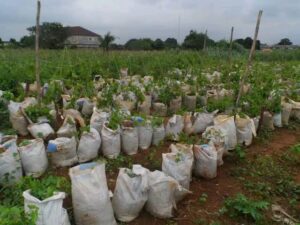
THE PROBLEMS & ADVANTAGES OF PLANTING YAM IN THE SACK IN NIGERIA
INTRODUCTION
Yam (Dioscorea spp.) is one of Nigeria’s most important staple crops, deeply embedded in the country’s food culture, economy, and agricultural system. Nigeria is the world’s leading producer of yam, contributing over 60% of global production, with key yam-producing states including Benue, Taraba, Niger, Ebonyi, and Enugu. Traditionally, yam cultivation is land-intensive, requiring vast farmland, deep and fertile soil, and extensive labor. However, as urbanization, land scarcity, and climate change intensify, alternative farming methods have become necessary. One such innovation is sack farming, a system where yams are cultivated in sacks filled with nutrient-rich soil and organic matter.
This method offers a solution for individuals with limited farmland, especially urban dwellers and small-scale farmers who wish to cultivate yams in backyards, balconies, rooftops, and urban gardens. Although promising, sack farming presents challenges that may affect productivity, cost-effectiveness, and sustainability. This paper explores the definition, explanation, advantages, and challenges of planting yam in sacks, providing well-researched insights supported by real-life applications and expert opinions.
DEFINITION OF SACK FARMING FOR YAM
Sack farming, also known as container-based cultivation, is an agricultural technique that involves growing crops in vertically positioned sacks filled with soil, compost, and other organic matter. It is particularly useful in urban agriculture, climate-adaptive farming, and small-scale food production. In Nigeria, this method is being adopted due to land scarcity, high cost of farmland, and soil degradation in traditional farming areas.
Yam sack farming is gaining traction among smallholder farmers in densely populated cities such as Lagos, Abuja, Port Harcourt, and Kano, where land is expensive or unavailable. Additionally, it is being tested in regions affected by desertification, erosion, and flooding, where traditional land-based yam farming faces significant challenges.
EXPLANATION OF SACK FARMING FOR YAM
The process of growing yams in sacks involves several key steps, from material selection to harvesting. A detailed breakdown of the method is provided below:
1. Selecting the Sack – The sack must be durable, breathable, and large enough to accommodate yam tuber expansion. Materials such as jute, polypropylene, or thick plastic sacks are commonly used. The recommended size is at least 50 cm in diameter and 1 meter in height.
2. Soil Preparation – A well-drained, loamy soil rich in organic matter is ideal for yam growth. A mixture of topsoil, sand, compost, and decomposed manure is prepared to provide adequate nutrients. Proper aeration is maintained to prevent soil compaction.
3. Planting the Yam Setts – Yam setts, either minisetts or vine cuttings, are planted at a depth of 5-10 cm in the sack. Some farmers use a multi-layered approach, planting one sett at the bottom and another at the middle to maximize sack space.
4. Providing Support Structures – Since yams are climbing plants, a staking system is necessary. Farmers use bamboo poles, wooden stakes, or trellises to provide support for the vines, ensuring better exposure to sunlight and improved photosynthesis.
5. Watering and Fertilization – Unlike traditional farming, sack yams require regular but controlled watering to maintain optimal moisture levels. Organic fertilizers such as poultry droppings, compost tea, or liquid manure are periodically added to replenish nutrients.
6. Weed and Pest Control – Sack farming minimizes weed infestation, but pest control is still necessary. Organic pesticides, neem extracts, and companion planting with crops like basil or marigold help reduce pest attacks.
7. Harvesting the Yam Tubers – Depending on the variety, yams mature within 6-8 months. The sack is carefully cut open or emptied, ensuring minimal damage to the tubers. Proper curing is done before storage to improve shelf life.
ADVANTAGES OF PLANTING YAM IN THE SACK
1. OPTIMIZED LAND USE AND URBAN FARMING
With Nigeria’s rapid urbanization and shrinking agricultural land, sack farming allows yam cultivation in small spaces, making it an effective solution for urban and peri-urban areas. People in cities can now produce their own food without needing expansive farmlands.
2. IMPROVED SOIL MANAGEMENT AND FERTILITY CONTROL
Unlike open-field farming, sack farming enables better soil management. Farmers can regulate soil fertility, pH levels, and nutrient composition, reducing dependency on synthetic fertilizers. Additionally, crop rotation can be practiced by using the same sack for other crops after harvesting yams.
3. REDUCTION IN PEST AND DISEASE INFESTATION
Growing yams in sacks reduces exposure to soil-borne pests and diseases such as yam nematodes, root rot, and anthracnose. This leads to higher crop survival rates and lowers the need for chemical pesticides.
4. WATER CONSERVATION AND DROUGHT RESILIENCE
Sack farming provides better moisture retention compared to open-field farming, where excessive water loss occurs due to evaporation and runoff. This method is particularly beneficial in drought-prone areas such as northern Nigeria.
5. PROTECTION AGAINST FLOODING AND EROSION
Flooding is a major challenge for yam farmers in riverine areas. Sack farming elevates tubers above flood levels, reducing crop loss due to waterlogging and soil erosion.
6. BETTER QUALITY YAMS AND MARKET VALUE
Because sack yams do not come into direct contact with the soil, they develop smoother surfaces, making them more appealing for commercial sales and export. The reduced risk of rot also enhances their shelf life.
7. LOW-COST ENTRY FOR BEGINNERS AND SMALLHOLDER FARMERS
Individuals with limited financial resources can engage in yam sack farming without requiring large capital investments, making it accessible for youth, retirees, and small-scale entrepreneurs.
PROBLEMS OF PLANTING YAM IN THE SACK
1. LIMITED TUBER SIZE AND LOWER YIELDS
Due to space constraints, sack yams tend to produce smaller tubers compared to those grown in open fields. This can be a limiting factor for commercial-scale production.
2. SOIL COMPACTION AND POOR AERATION
Over time, the soil in sacks can become compacted, restricting root expansion and oxygen flow. This may lead to deformed or stunted yams. Proper soil aeration techniques such as mixing with sand or perlite are required to mitigate this issue.
3. HIGH MAINTENANCE REQUIREMENTS
Sack yams demand frequent monitoring, including watering, fertilization, and pest control. This makes the method more labor-intensive than traditional yam farming in some cases.
4. LIMITATIONS BASED ON YAM VARIETY
Certain yam species, such as Dioscorea alata (water yam), require deep soil penetration, making them less suited for sack farming. Farmers need to select compact yam varieties that adapt well to containerized environments.
CONCLUSION
Sack farming provides an innovative approach to yam cultivation in urban areas and land-constrained regions. It enhances space efficiency, conserves resources, and offers climate adaptation strategies. However, its limitations, such as smaller tuber sizes, high maintenance needs, and soil management challenges, must be addressed to optimize its full potential. With continued research, improved sack designs, and better agronomic practices, sack farming could contribute significantly to Nigeria’s food security, urban agriculture, and small-scale entrepreneurship.
REFERENCES
Food and Agriculture Organization (FAO), 2022. Yam Production in West Africa: Trends and Challenges.
Nigerian Institute for Agricultural Research, 2021. Urban Farming and Containerized Yam Cultivation in Nigeria.
Federal Ministry of Agriculture and Rural Development (FMARD), 2023. Climate-Resilient Yam Farming Techniques.
International Institute of Tropical Agriculture (IITA), 2020. Improving Yam Productivity Through Alternative Farming Methods.
Culled from Facebook





